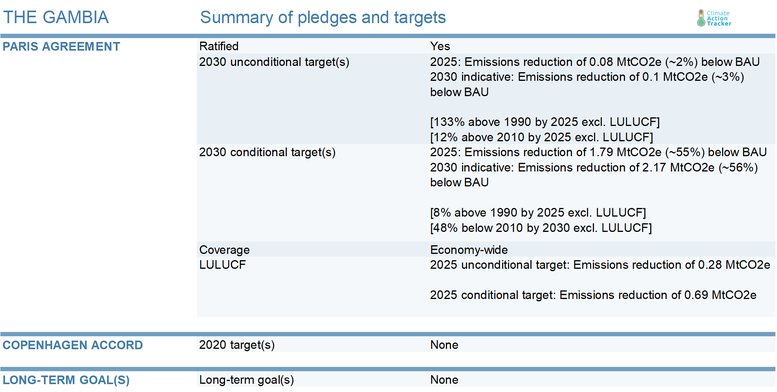Pledges And Targets
Summary table

Pledges and targets
On November 2016, The Gambia submitted its NDC (Government of The Gambia 2016). The NDC is comprised of a set of quantified sectoral measures for the period between 2021 and 2025. Some measures are conditional on financial and technical support, others are unconditional. The Gambia also provided estimates for the extent of abatement from these measures for 2030. We have included that in our analysis as an indicative target for 2030.
The Gambia’s unconditional 2025 target will reduce GHG emissions by 0.08 MtCO2e below BAU (excl. LULUCF) and will be achieved by deploying renewable energy. Its conditional target is estimated to abate an additional 1.71 MtCO2e (for a total of 1.79 MtCO2e) and will be reached through improving energy efficiency in the power system, and in the buildings, transport, agriculture and waste sectors, as well as expanding its renewable energy target.
The Gambia also plans to unilaterally abate 0.28 MtCO2e in the LULUCF sector through afforestation by 2025. Conditional on international support, it will abate an additional 0.29 MtCO2e by using efficient cook stoves to reduce the overuse of forest resources.
By 2030, implementation of the unconditional mitigation targets would result in emissions reductions of 0.10 MtCO2e excl. LULUCF, while the conditional actions would lead to an additional abate of 2.07 MtCO2e (for a total of 2.17 MtCO2e). For the land sector, The Gambia would abate 0.33 MtCO2e and an additional 0.68 MtCO2e with support.
The total expected mitigation from all of these actions would result in an emissions level of 1.47 MtCO2e excl. LULUCF in 2025, which is equivalent to 55% below the BAU scenario. The NDC target value is calculated based on the conditional and unconditional mitigation actions and their estimated impact as listed in The Gambia’s NDC. It should be noted that the NDC text at one point states a reduction of 44.4% below the BAU scenario by 2025 while we have used the 55% reduction target throughout this assessment.
The NDC indicated that there are “low” and “medium” emissions BAU scenarios. The NDC is relative to the low emissions BAU scenario. According to its NDC, The Gambia’s emissions are projected to grow by 3% annually until 2030. It indicates there are other scenarios assuming higher economic growth, but those have not been made publicly available.
The Gambia plans to enhance and update its NDC in 2020, but further details as well as the concrete timeline remain unclear (WRI Climate 2019).
Further analysis
Latest publications
Stay informed
Subscribe to our newsletter




